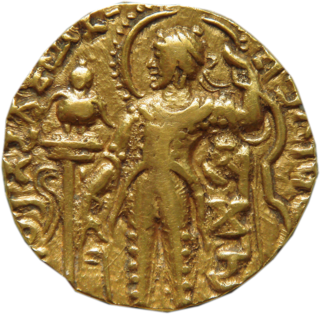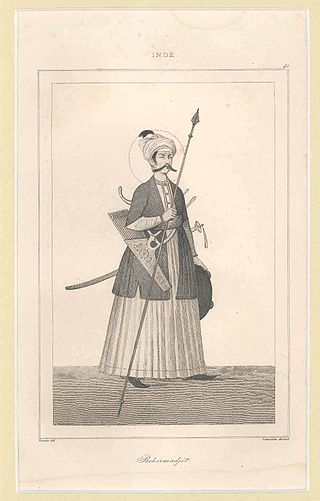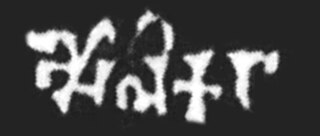The Gupta Empire was an ancient Indian empire on the Indian subcontinent which existed from the mid 3rd century to mid 6th century CE. At its zenith, the dynasty ruled over an empire that spanned much of northern India. This period has been considered as the Golden Age of India by historians, although this characterisation has been disputed by some other historians. The ruling dynasty of the empire was founded by Gupta.

Chandragupta II, also known by his title Vikramaditya, as well as Chandragupta Vikramaditya, was the Gupta emperor. Modern scholars generally identify him with King Chandra of the Delhi iron pillar inscription.

Chandragupta I was a monarch of the Gupta Empire, who ruled in northern and central India. His title Mahārājadhirāja suggests that he was the first suzerain ruler of the dynasty. It is not certain how he turned his small ancestral kingdom into an empire, although a widely accepted theory among modern historians is that his marriage to the Licchavi princess Kumaradevi helped him extend his political power. Their son Samudragupta further expanded the Gupta Empire.

Samudragupta (Gupta script: Sa-mu-dra-gu-pta, was the second emperor of the Gupta Empire of ancient India, and is regarded among the greatest rulers of India. As a son of the Gupta emperor Chandragupta I and the Licchavi princess Kumaradevi, he greatly expanded his dynasty's political and military power.

Malwa is a historical region of west-central India occupying a plateau of volcanic origin. Geologically, the Malwa Plateau generally refers to the volcanic upland north of the Vindhya Range. Politically and administratively, it is also synonymous with the former state of Madhya Bharat which was later merged with Madhya Pradesh. At present the historical Malwa region includes districts of western Madhya Pradesh and parts of south-eastern Rajasthan. Sometimes the definition of Malwa is extended to include the Nimar region south of the Vindhyas.

Ramagupta, according to the Sanskrit play Devichandraguptam, was an emperor of the Gupta dynasty of northern India. The surviving fragments of the play, combined with other literary evidence, suggest that he agreed to surrender his wife Dhruvadevi to a Shaka enemy: However, his brother Chandragupta II killed the Shaka enemy, and later dethroned him, marrying Dhruvadevi.
Nagabhata I was the founder of the imperial Pratihara dynasty in northern India. He ruled the Avanti region in present-day Madhya Pradesh, from his capital at Ujjain. He may have extended his control over Gurjaradesa, which includes parts of present-day Gujarat and Rajasthan. He repulsed an Arab invasion from Sindh, probably led by Junayd ibn Abd al-Rahman al-Murri or Al Hakam ibn Awana.
The Western Satraps, or Western Kshatrapas were Indo-Scythian (Saka) rulers of the western and central parts of India, between 35 and 415 CE. The Western Satraps were contemporaneous with the Kushans who ruled the northern part of the Indian subcontinent, and were possibly vassals of the Kushans. They were also contemporaneous with the Satavahana who ruled in Central India. They are called "Western Satraps" in modern historiography in order to differentiate them from the "Northern Satraps", who ruled in Punjab and Mathura until the 2nd century CE.

Avanti was an ancient Indian Mahajanapada, roughly corresponding to the present-day Malwa region. According to the Buddhist texts, the Anguttara Nikaya, Avanti was one of the solasa mahajanapadas of the 6th century BCE. The janapada was divided into two parts by the Vindhyas, the northern part had its capital at Ujjayini and the southern part had its centre at Mahishmati.

Vikramaditya was a legendary king as mentioned in ancient Indian literature, featuring in traditional stories including those in Vetala Panchavimshati and Singhasan Battisi. Many describe him as ruler with his capital at Ujjain. "Vikramaditya" was also a common title adopted by several monarchs in ancient and medieval India, and the Vikramaditya legends may be embellished accounts of different kings. According to popular tradition, Vikramaditya began the Vikrama Samvat era in 57 BCE after defeating the Shakas, and those who believe that he is based on a historical figure place him around the first century BCE. However, this era is identified as "Vikrama Samvat" after the ninth century CE.

Arjunayana, Arjunavana, Arjunavayana or Arjunayanaka was an ancient republican people located in Punjab or north-eastern Rajasthan. They emerged as a political power during the Shunga period. In the Allahabad Pillar Inscription of Samudragupta, the Arjunayanas figure among the autonomous political communities bordering on the Gupta Empire who accepted the overlordship of Samudragupta. They are also mentioned in Bṛhat Saṃhitā of Varahamihira. According to Dr Buddha Prakash, the Arjunayanas are mentioned as Prajjunakas in Kautiliya's text Arthashastra which also places them in the northern division of India. Vincent Smith locates their republic in Alwar and Bharatpur states now in Rajasthan, a view which has been rejected by R. C. Majumdar. They are mentioned in the literary sources in Afghanistan from 4th century BCE and after Alexander's invasions in 3rd century they have been mentioned in Agra, Mathura and Southern Haryana region till 4th century CE where their coins have been found too.

The Paramara Dynasty was an Indian dynasty that ruled Malwa and surrounding areas in west-central India between 9th and 14th centuries. They belonged to the Paramara clan of the Rajputs.
There are conflicting theories regarding the original homeland and ancestry of the Gupta dynasty that ruled northern India between 4th and 6th centuries. Modern historians variously theorize that it originated in present-day Uttar Pradesh or Bengal, based on epigraphic, numismatic and literary evidence. The social group (varna) of the dynasty is also a matter of debate, with scholars variously placing them in Vaishya, Brahmana, or other categories.

The Aulikaras, were an ancient clan that ruled the Kingdom of Daśapura between the 4th-century CE and 6th-century CE.
Gurjaradesa, is a historical region in India comprising the southern Rajasthan and northern Gujarat during the period of 6th–12th century CE. The predominant power of the region, the Gurjara-Pratiharas eventually controlled a major part of North India centered at Kannauj. The modern state of "Gujarat" derives its name from the ancient Gurjaratra.
The origin of the Gurjara-Pratihara dynasty of India is a topic of debate among historians. The rulers of this dynasty used the self-designation "Pratihara" for their clan, but have been described as "Gurjara" by their neighbouring kingdoms. Only one particular inscription of a feudatory ruler named Mathanadeva mentions him as a "Gurjara-Pratihara".

The Kalachuris of Mahismati, or the Early Kalachuris, were an early medieval Indian dynasty that ruled present-day Maharashtra, as well as parts of mainland Gujarat and southern Madhya Pradesh. Their capital was located at Mahishmati. Epigraphic and numismatic evidence suggests that the earliest of the Ellora and Elephanta cave monuments were built during the Kalachuri rule.

The Gupta era is a historical calendar era that begins from c. 318–319 CE. It was used by the Gupta emperors, as well as their vassals and their successors in present-day northern India and Nepal. It is identical to the Vallabhi era, which was used in the Saurashtra region of western India, although regional differences lead to a slightly different calculation for the conversion of Vallabhi era years to Common Era (CE).
The Second Aulikara dynasty was a royal dynasty that ruled over the Kingdom of Daśapura, and at its peak under Yashodharman Vishnuvardhana controlled a vast area, consisting of almost all of Northern India and parts of Deccan plateau. It was the second royal house of the Aulikara clan.
The Abhira dynasty was a dynasty that ruled over the western Deccan, where it perhaps succeeded the Satavahana dynasty. From 203 to roughly 270 or 370, this dynasty formed a vast kingdom. The Abhiras had an extensive empire comprising modern-day Maharashtra, Konkan, Gujarat and parts of southern Madhya Pradesh. Some scholars regard the Abhiras as a great almost an imperial power in the third century A.D.














